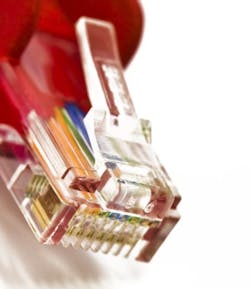Direct-connect termination method to be recognized in TIA-568 standard document
During its February 2017 meeting, the TIA TR-42.7 subcommittee, which establishes standards related to twisted-pair cabling systems, agreed it will include the connection method sometimes call “direct-connect” in a normative annex to the TIA-568.2-D standard. Using this connection method, the cabling installer terminates horizontal twisted-pair cable to a plug. TR-42.7 is using the term “modular plug terminated link” in the current draft of 568.2-D.
At its February meeting, TR-42.7 resolved comments in the standard-development stage known as mock ballot, and authorized the issuance of a first committee ballot. The TIA-568.2-D document is still several steps away from approval and publication, but the inclusion of the modular plug terminated link is a noteworthy milestone.
Ron Tellas, Belden’s LAN technology and applications manager, covered this standards development in a blog post on February 10. Tellas is a member of TR-42.7 and attended the subcommittee’s February meeting. On The Belden Blog, Tellas said, “We’re always looking out for the ICT industry, searching for ways to improve existing technology and streamlined installation—which is why we presented the problem to TIA and led the effort to have a direct-connect termination method fully supported.
“What does that mean? Now, RJ45 modular plugs can be terminated directly onto horizontal cabling and measured in the field. This allows a variety of devices, such as wireless access points, surveillance cameras and HDBase-T monitors, to be plugged without the need for an outlet and a patch cord.”
Tellas further explained: “ANSI/TIA-568-C.2 currently requires horizontal cable to be terminated on a telecommunications outlet to provide flexible user access. But TIA also realizes that, in certain cases, there is a need to terminate horizontal cables to a plug that is directly plugged into a device. Direct-connect assembly uses a single cable to connect a device at one end; the other cable end is terminated with a jack in a patch panel in the telecommunications room. This allows for efficient power delivery with the lowest channel insertion loss and gives installers the flexibility to eliminate the need for a jack and cord to connect devices.”
The image on this page is taken from Ron Tellas’s blog post and illustrates the testing of a modular plug terminated link (MPTL). Tellas noted, “During testing, the MPTL will have a jack on one end and a plug on the other end, with an optional consolidation point (plug-to-plug isn’t supported). Proper testing requires a permanent link adapter and a patch cord test head.”
Also, importantly, Tellas pointed out that the MPTL must comply with the permanent link transmission requirements of ANSI/TIA-568-C.2 clause 6.3 in order to be recognized.
